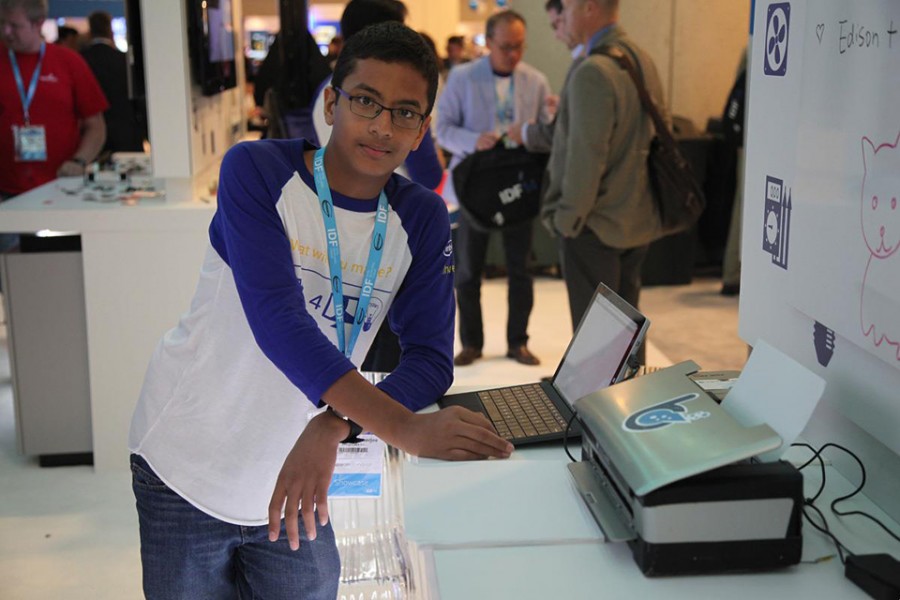EDUCATION: What’s the Maker Movement about? Reinventing the world one child at a time
Shubham Banerjee shows off his Braille printer. The 13-year-old started his own company with financial and technological backing from Intel. (Brandpoint photo)
June 9, 2015
Can kids playing with Legos make the world a better place? Will children who build their own rocket ships or dollhouses go on to be the adult innovators of tomorrow, who take on the world’s challenges with technology and creativity? If 13-year-old Shubham Banerjee is an example of young makers, the answer to those questions may be a resounding “Yes.”
After reading that most Braille printers cost more than $2,000, Shubham decided this price was “crazy” and set out to create a cheaper alternative. Using a Lego kit and parts from a local hardware store, he built a prototype Braille printer of his own. The price? About $350. With financial and technology backing from Intel, Shubham founded his own company and is now working on a more advanced, low-cost Braille printer based on the postage-stamp size Intel Edison computing platform.
Shubham’s story is amazing and inspiring — and less of an exception than you might think. His story is one of the many successes emerging from the Maker Movement. Makers come from all socio-economic backgrounds and are all ages. They use technology and creativity to reinvent the world around them, whether it’s adding motion-sensitive LED lights to Barbie’s outfit, creating a tweetable coffee pot or using sensors to create an app-enabled watering system for their houseplants. Many, like Shubham, are employing their skills as makers to create their own career opportunities.
“The lesson for all of us is that making and exploring through play is not just about celebrating the gifted but about triggering and encouraging the talent living inside every child,” says Jay Melican, Intel’s maker czar. “Study after study supports that the best way to activate a curious mind is to make something. That might be an amazing high-tech invention or a messy science experiment. This shift to making represents the perfect storm of new technological materials, expanded opportunities, learning through hands-on experience and the basic human impulse to create.”
Affordable technology and the ability to share online has fueled the Maker Movement. New tools such as 3D printers, robotics, affordable microprocessors such as the Intel Galileo or Intel Edison development boards and new programming languages are enabling hands-on learning and encouraging children of all ages to use these tools to move from passive receivers of knowledge to real-world makers. For the first time, students can take their powerful ideas to create real things, not just make-believe models. Kids can solve real problems with their own inventions and easily explore science, technology, engineering and math (STEM) career opportunities.
The Maker Movement holds the promise to specifically inspire girls to pursue STEM studies and even careers. An Intel study, called MakeHers, found that the social-service aspects motivate female makers and that girl makers develop more interest and skills in computer science and engineering.
Parents and teachers of school-age children may already unwittingly participate in the Maker Movement when children use tablets in the classroom, play coding games or build a soapbox car at home. Attending a Maker Faire is a great way to learn more about the world of making and inspire kids of all ages.
Heralded as the “greatest show-and-tells on Earth,” the Maker Faire in San Mateo annually attracts more than 145,000 children and adults over just one weekend. Hundreds of Maker Faires are held around the world throughout the year. They gather to make things, show off, challenge one another, laugh, play, invent, tinker, solve problems and inspire.
Excitement, rather than expertise, is the coin of the realm in this magical environment full of fire-breathing sculptures, cupcake cars, bicycle-powered rock bands, soda and Mentos-propelled fountains and workshops in programming, soldering, welding, lock-picking, knitting, crocheting and robot making.
To learn more and to find a Maker Faire near you, visit www.makerfaire.com.
This content is published as part of the North Coast Current Merchants’ Square, an advertising supplement offering businesses an opportunity to connect directly with north San Diego County readers. If you would like to promote your business or sponsor content in Merchants’ Square, email ads@northcoastcurrent.com.





